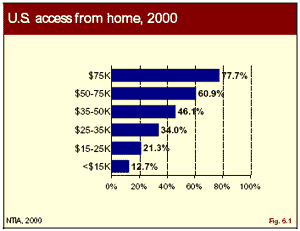The above example, and other examples of digital divides, are important policy problematics because the integration of information and communication technologies into society, work, and governance is pervasive and inevitable. People need to be competent in communication and technology in order to be full participants in society. This is increasingly important and will be critical for those who are already marginalized in society due to other social and economic factors.
The United States, like Canada, has made considerable strides in connecting its citizens, and, like Canada, features differential levels of access based on such variables as class, education/skills, geography, and lack of need/interest. In a comparison of general access trends from home and public locations, Canada is faring better than the United States.

Source: Falling Through the Net: Toward Digital Inclusion,
National Telecommunications and Information Administration,
October, 2000.